Elizabeth A. George Cisar
B.S., The University of North Carolina, Chapel Hill
Mechanism of Signal Transduction by the Staphylococcus aureus Quorum Sensing Receptor AgrC
presented by Tom W. Muir
Elizabeth George Cisar joined our graduate program right out of high school. Prior to high school, she’d actually graduated from UNC Chapel Hill, with a degree in chemistry. Now if you’re not already confused, Beth spent the first year of her high school up in Ithaca, New York, at Cornell before joining my lab in the summer of 2004. For her thesis, Beth studied how virulence is regulated in pathogenic staphylococcus bacteria through something called quorum sensing. So for the nonspecialist, staph in many ways act like soccer hooligans. When they’re on their own, they’re utterly docile and harmless, but get them in a crowd, particularly in the presence of the right chemical stimulant, and you’d better watch out. Indeed, staph turn on their very own response, the ability of the infection to spread, only when their numbers have reached a certain threshold, hence the term “quorum sensing.”
So how does this work? Well, during her time here, Beth focused on the molecular language by which these bugs talk to each other. Using a combination of chemistry and genetic tools, Beth was able to listen in on their conversations and discovered something really quite unexpected, namely that the protein receptors involved in sensing the quorum operate through what she refers to as symmetrical signaling. Now this is really hard to explain, even to the aficionados, it turns out, but I’ll try using the following analogy. Imagine you’re looking at a mirror, and you put out your hand to touch your reflected image, only to find that the hand emerges from the mirror and touches you at the same time. Pretty weird stuff. When she first told me about this, I actually thought she’d spent too much time listening to bugs. But sure enough, Beth was right. Her work clearly showed that the receptor histidine kinase proteins that sense the quorum are paired up, and activation of just one component of the dimer automatically activates its partner. This, she believes, provides an amplification mechanism that drives the sensing process. Beth will shortly move out to The Scripps in La Jolla, where she will carry out postdoctoral studies, in a sense mirroring my own career path. She will move there with her husband Justin, who is also a student in the Tri-Institutional Chemical Biology Program — that’s why they spent a year in Ithaca. And just one last thing. For those of you wondering how Beth could have obtained an undergraduate education before going to high school, she taught high school chemistry after going to UNC.


